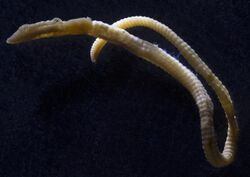Biology:Lake Pedder earthworm: Difference between revisions
(update) |
Wikisleeper (talk | contribs) (over-write) |
||
| Line 1: | Line 1: | ||
{{redirect-distinguish2|Hypolimnus|the butterfly genus ''[[Biology:Hypolimnas|Hypolimnas]]''}} | |||
{{Use Australian English|date=August 2019}} | {{Use Australian English|date=August 2019}} | ||
{{short description|Earthworm species}} | {{short description|Earthworm species}} | ||
| Line 4: | Line 5: | ||
{{Speciesbox | {{Speciesbox | ||
| name = Lake Pedder earthworm | | name = Lake Pedder earthworm | ||
| image = | | image = Hypolimnus pedderensis Wikipedia.jpg | ||
| image_caption = [[Biology:Holotype|Holotype]] specimen collected in February 1971, the only known specimen of this species in existence. Photographed at Museum of Tasmania Collections and Research Facility | |||
| status = EX | | status = EX | ||
| extinct = 1972 | | extinct = 1972 | ||
| status_system = IUCN3.1 | | status_system = IUCN3.1 | ||
| parent_authority = | | parent_authority = Blakenmore, 2000 | ||
| display_parents = 2 | | display_parents = 2 | ||
| genus = Hypolimnus | | genus = Hypolimnus | ||
| Line 14: | Line 16: | ||
| authority = (Jamieson, 1974) | | authority = (Jamieson, 1974) | ||
| synonyms = | | synonyms = | ||
''Atlantodrilus pedderensis'' (''[[Biology:Nomen nudum|nomen nudum]]'')<br /> | ''Atlantodrilus pedderensis'' <small>(''[[Biology:Nomen nudum|nomen nudum]]'')</small><br /> | ||
''Diporochaeta pedderensis'' (Jamieson, 1974)<br /> | ''Diporochaeta pedderensis'' <small>(Jamieson, 1974)</small><br /> | ||
''Perionychella pedderensis'' Jamieson, 1974 | ''Perionychella pedderensis'' <small>Jamieson, 1974</small> | ||
|status_ref=<ref name= | |status_ref= <ref name=IUCN>{{cite iucn |author=Blakenmore, R.J. |date=2003 |title=''Hypolimnus pedderensis'' |volume=2003 |page=e.T41254A10424837 |doi=10.2305/IUCN.UK.2003.RLTS.T41254A10424837.en |access-date=22 February 2024}}</ref> | ||
}} | }} | ||
The '''Lake Pedder earthworm''' ('''''Hypolimnus pedderensis''''') is an extinct [[Biology:Earthworm|earthworm]] [[Biology:Species|species]] in the [[Social:Family|family]] [[Biology:Megascolecidae|Megascolecidae]].<ref name=IUCN/><ref name="Australian Faunal Directory"/> Its [[Biology:Genus|genus]] '''''Hypolimnus''''' is monotypic.<ref name=ITIS/> | |||
The '''Lake Pedder earthworm''' (''Hypolimnus pedderensis'') is an extinct [[Biology:Earthworm|earthworm]] [[Biology:Species|species]] in the family [[Biology:Megascolecidae|Megascolecidae]]. Its [[Biology:Genus|genus]] '''''Hypolimnus''''' is monotypic. | |||
It was [[Biology:Endemism|endemic]] to the Lake Pedder area in Tasmania, | It was [[Biology:Endemism|endemic]] to the Lake Pedder area in Tasmania, Australia, prior to its flooding in 1972 for a hydro-electric power scheme. It is only known from the [[Biology:Holotype|holotype]] specimen collected from a Lake Pedder beach in 1971. A 1996 survey failed to find it and it is presumed extinct.<ref name=IUCN/> | ||
It is only known from | |||
The Lake Pedder earthworm mainly fed on microbes or algae on sand particles. Their feeding habits were seen to have a considerable impact on the banks of the lake, as the particles they consumed were deposited on the surface of the ground in the form of castings. As these castings were exposed to air, the soil was aerated, improving both the drainage and water holding capacity of the soil.<ref>{{Cite journal|last= De Vos|first=Rick|date=2019-09-25|title=Inundation, Extinction and Lacustrine Lives|url=https://epress.lib.uts.edu.au/journals/index.php/csrj/article/view/6394|journal=Cultural Studies Review|language=en|volume=25|issue=1|pages=102–118|doi=10.5130/csr.v25i1.6394|issn=1837-8692|doi-access=free}}</ref> | The Lake Pedder earthworm mainly fed on microbes or algae on sand particles. Their feeding habits were seen to have a considerable impact on the banks of the lake, as the particles they consumed were deposited on the surface of the ground in the form of castings. As these castings were exposed to air, the soil was aerated, improving both the drainage and water holding capacity of the soil.<ref>{{Cite journal|last= De Vos|first=Rick|date=2019-09-25|title=Inundation, Extinction and Lacustrine Lives|url=https://epress.lib.uts.edu.au/journals/index.php/csrj/article/view/6394|journal=Cultural Studies Review|language=en|volume=25|issue=1|pages=102–118|doi=10.5130/csr.v25i1.6394|issn=1837-8692|doi-access=free}}</ref> | ||
==References== | ==References== | ||
{{Reflist}} | {{Reflist|refs= | ||
<ref name="Australian Faunal Directory">{{cite web |url=https://biodiversity.org.au/afd/taxa/Hypolimnus_pedderensis |title=Species ''Hypolimnus pedderensis'' (Jamieson, 1974 (extinct)) |author= |date= |work=Australian Faunal Directory |publisher=Department of Climate Change, Energy, the Environment and Water |access-date=22 February 2024}}</ref> | |||
<ref name=ITIS>{{ITIS |id=974472 |taxon=''Hypolimnus'' Blakemore, 2000 |access-date=22 February 2024}}</ref> | |||
}} | |||
{{SouthWestTasmania |state=autocollapse}} | |||
{{Taxonbar|from=Q5238873}} | {{Taxonbar|from=Q15156397 |from2=Q5238873}} | ||
[[Category:Megascolecidae]] | [[Category:Megascolecidae]] | ||
Latest revision as of 18:56, 27 May 2025
| Lake Pedder earthworm | |
|---|---|

| |
| Holotype specimen collected in February 1971, the only known specimen of this species in existence. Photographed at Museum of Tasmania Collections and Research Facility | |
| Scientific classification Error creating thumbnail: Unable to save thumbnail to destination
| |
| Domain: | Eukaryota |
| Kingdom: | Animalia |
| Phylum: | Annelida |
| Class: | Clitellata |
| Order: | Opisthopora |
| Suborder: | Lumbricina |
| Family: | Megascolecidae |
| Genus: | Hypolimnus Blakenmore, 2000 |
| Species: | †H. pedderensis
|
| Binomial name | |
| †Hypolimnus pedderensis (Jamieson, 1974)
| |
| Synonyms | |
|
Atlantodrilus pedderensis (nomen nudum) | |
The Lake Pedder earthworm (Hypolimnus pedderensis) is an extinct earthworm species in the family Megascolecidae.[1][2] Its genus Hypolimnus is monotypic.[3]
It was endemic to the Lake Pedder area in Tasmania, Australia, prior to its flooding in 1972 for a hydro-electric power scheme. It is only known from the holotype specimen collected from a Lake Pedder beach in 1971. A 1996 survey failed to find it and it is presumed extinct.[1]
The Lake Pedder earthworm mainly fed on microbes or algae on sand particles. Their feeding habits were seen to have a considerable impact on the banks of the lake, as the particles they consumed were deposited on the surface of the ground in the form of castings. As these castings were exposed to air, the soil was aerated, improving both the drainage and water holding capacity of the soil.[4]
References
- ↑ 1.0 1.1 1.2 Blakenmore, R.J. (2003). "Hypolimnus pedderensis". IUCN Red List of Threatened Species 2003: e.T41254A10424837. doi:10.2305/IUCN.UK.2003.RLTS.T41254A10424837.en. https://www.iucnredlist.org/species/41254/10424837. Retrieved 22 February 2024.
- ↑ "Species Hypolimnus pedderensis (Jamieson, 1974 (extinct))". Australian Faunal Directory. Department of Climate Change, Energy, the Environment and Water. https://biodiversity.org.au/afd/taxa/Hypolimnus_pedderensis.
- ↑ "Hypolimnus Blakemore, 2000". Integrated Taxonomic Information System. https://www.itis.gov/servlet/SingleRpt/SingleRpt?search_topic=TSN&search_value=974472.
- ↑ De Vos, Rick (2019-09-25). "Inundation, Extinction and Lacustrine Lives" (in en). Cultural Studies Review 25 (1): 102–118. doi:10.5130/csr.v25i1.6394. ISSN 1837-8692. https://epress.lib.uts.edu.au/journals/index.php/csrj/article/view/6394.
Wikidata ☰ Q15156397 entry
 |


